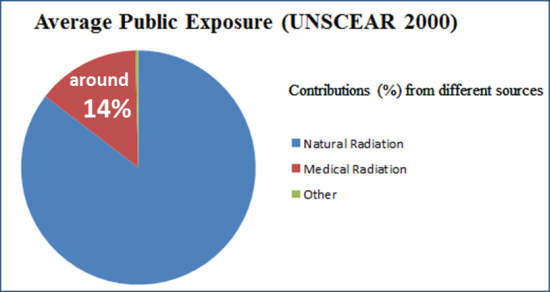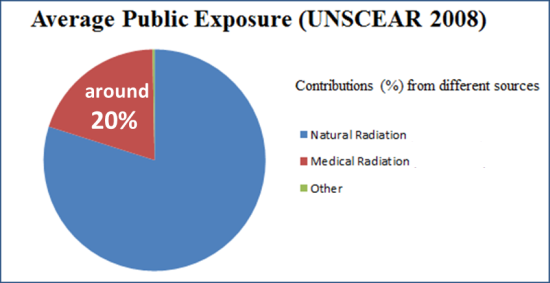Medical Radiation
Medical Radiation
MOK Wai-ling and CHAN Siu-wai
April 2015
The radiation that we normally receive comes from the exposure to natural background radiation and artificial radiation [1,2]. Sources of natural background radiation consist mainly of cosmic rays, terrestrial radiation, intake of natural radionuclides from air (such as radon gas) and from foodstuff. According to the United Nations Scientific Committee on the Effects of Atomic Radiation [3,4], natural background radiation contributes to nearly 80% of the average total radiation dose the human receives. Medical radiation is the largest artificial source of radiation exposure. Its contribution to the average public exposure increased from around 14% in 2000 to about 20% in 2008 (Figure 1) [3,4]. During the period, all other sources of artificial radiation contributed less than 1% of the average public exposure.
The medical uses of radiation will likely continue to increase as new technologies develop and become more widely adopted. It is believed that the extensive use of radiation in medical diagnosis and therapy should in general bring improvement to the diagnosis and treatment of human diseases [3]. Anyhow, the risks related to the medical radiation exposure of human could also increase. To address this issue, the International Atomic Energy Agency (IAEA) and the World Health Organization (WHO) issued a Joint Position Statement, 'Bonn Call-for-Action' [5], in 2013 which aims at :
- strengthening the radiation protection of patients and health workers overall;
- attaining the highest benefit with the least possible risk to all patients by the safe and appropriate use of ionizing radiation in medicine;
- aiding the full integration of radiation protection into health care systems;
- helping improve the benefit/risk-dialogue with patients and the public; and
- enhancing the safety and quality of radiological procedures in medicine.
- strengthening the radiation protection of patients and health workers overall;
- attaining the highest benefit with the least possible risk to all patients by the safe and appropriate use of ionizing radiation in medicine;
- aiding the full integration of radiation protection into health care systems;
- helping improve the benefit/risk-dialogue with patients and the public; and
- enhancing the safety and quality of radiological procedures in medicine.


Figure 1 The contribution of medical radiation to the average public exposure increased from around 14% in 2000 to around 20% in 2008 (Source: [3, 4]).
References:
[1] "Where does Radiation Come from?", Hong Kong Observatory webpage
[2] "Variations in the Environmental Radiation Levels around the World", Hong Kong Observatory webpage
[3] United Nations Scientific Committee on the Effects of Atomic Radiation (UNSCEAR) 2008 Report
[4] United Nations Scientific Committee on the Effects of Atomic Radiation (UNSCEAR) 2000 Report
[5] IAEA webpage for Radiation Protection of Patients
[1] "Where does Radiation Come from?", Hong Kong Observatory webpage
[2] "Variations in the Environmental Radiation Levels around the World", Hong Kong Observatory webpage
[3] United Nations Scientific Committee on the Effects of Atomic Radiation (UNSCEAR) 2008 Report
[4] United Nations Scientific Committee on the Effects of Atomic Radiation (UNSCEAR) 2000 Report
[5] IAEA webpage for Radiation Protection of Patients